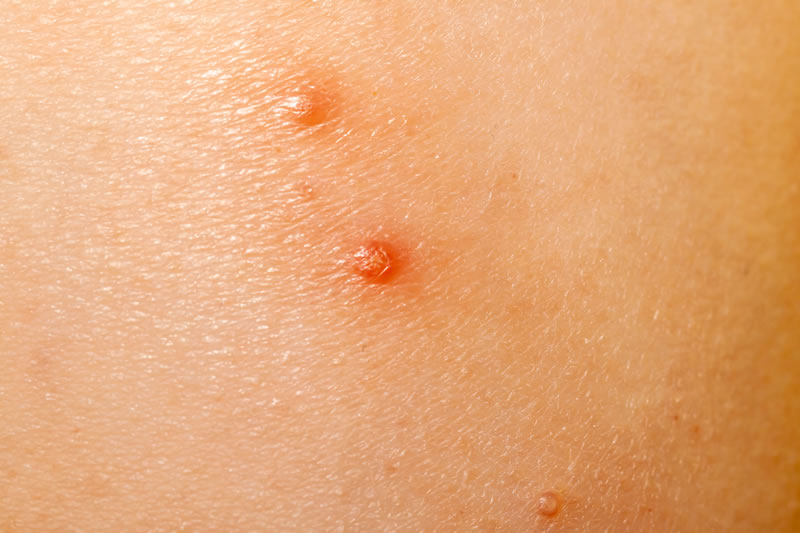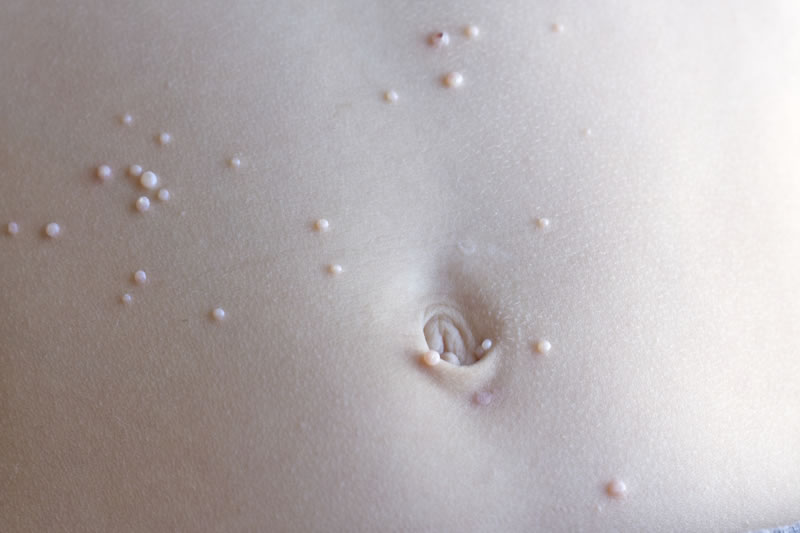Molluscum Contagiosum Treatment
Molluscum contagiosum is a viral infection of the skin caused by the pox virus, and has become increasingly common in the United States. It is a very common infection in young children (aged 1-10 years old), but this viral skin infection also affects adults. In younger children, this infection commonly spreads through children playing in day care centers or in gym classes. In adults, molluscum contagiosum often presents as an STD, and prompt treatment is necessary to prevent the spread of this contagious skin disease.
Molluscum contagiosum is spread from person to person, through direct contact or through shared items such as towels and clothing. The main mechanism of spread of the Molluscum contagiosum virus is via direct skin-to-skin contact. The virus can also spread from one part of the body to another through autoinoculation (scratching an affected area and touching other parts of the body). It is vital to seek prompt treatment of this contagious skin condition, and stop its spread.
If you think you may be experiencing molluscum contagiosum, dermatologist Dr. Michele Green can work with you to diagnose your symptoms and create a comprehensive treatment plan.

Symptoms of Molluscum Contagiosum
The incubation period for molluscum contagiosum infections is between 2-7 weeks, but symptoms of the skin disease may not appear for up to six months. Molloscum is common on the trunk, arms, and legs, and consists of dome shaped, groups of painless, lesions with a dimple on the surface. Once symptoms appear, you may observe singular or patches of up to 20 papules, or skin lesions, on the surface of the skin, which easily spread. These are typically painless, and have one or more of the following characteristics:
- Shiny or smooth exterior
- Waxy interior
- Dome-shaped with a dimple on the top
- White, pink, or skin-colored
- 2-5 mm in diameter (slightly larger than a pin head)
These papules are present along the trunk and limbs of the body, but typically do not develop on the palms of the hands or soles of the feet. In order to confirm diagnosis of molluscum contagiosum, your health care provider will sometimes do a skin biopsy or scraping, but often can diagnose based off of these classic symptoms.
Risk Factors
Molluscum contagiosum can affect anyone who has come into contact with the virus, either through physical contact, contact sports, transmission through towels or shared clothing, or through sexual contact, particularly if papules are present in the genital area during a sexual exchange. Nevertheless, the Centers for Disease Control and Prevention (CDC) highlights the following groups for increased risk:
- Children between the ages of 1-10
- People with weakened immune systems
- People with previously existing skin conditions, such as atopic dermatitis (eczema)
- People who live in crowded, warm and human living conditions
Furthermore, patients with weakened immune systems or with other immune styseme-based skin conditions, such as those with HIV/AIDS or with atopic dermatitis, can experience more severe symptoms. In the case of immunocompromised patients, skin lesions can become quite large in size (up to 15mm in diameter), and can be more resistant to standard treatments.
Treatment of Molluscum Contagiosum
Because molluscum contagiosum is a viral skin infection that generally is self-limited with healthy infected persons, medical treatment is not always essential. However, the presence of papules on sensitive parts of the body (either on the face or near the genital area), as well as the contagious nature of the virus may prompt you to reach out to your dermatologist or primary care doctor. A qualified health care professional, like Dr. Michele Green, is able to provide the following treatment options:
Physical Removal
A physical removal process can be done through one of the following treatments:
- Cryotherapy, in which the papule is frozen liquid nitrogen and thus removed
- Curettage, during which the papule is punctured and scraped off of the skin
- Pulsed-dye laser therapy, via the Vbeam laser treatment, during which time the skin cells of the molluscum papule are destroyed. The Vbeam laser utilizes a 595 wavelength of laser light to destroy these viral cells.
Topical Therapy
Topical therapy processes can be necessary for large quantities of molluscum contagiosum bumps. Several different topical options are available, including the following:
- Podophyllotoxin cream, a reliable at-home treatment. It is not recommended for pregnant patients, as the active ingredient may be harmful to a developing fetus
- Trichloroacetic acid: safe to use on delicate areas of the body, and a standard topical treatment for warts and skin lesions
- Imiquimod cream: helps to boost the immune system of the patient expericing molluscum contagiosum infection, thus aiding the body to eliminate the virus.
- Potassium hydroxide: a liquid applied twice daily to the skin lesion. Once the spots appear inflamed, treatment halts and the skin is able to repair the affected area.
- Tretinoin: also a liquid application. It is not recommended for pregnant patients, and may cause sensitivity to sunlight or ultraviolet light
- Salicylic acid: a common ingredient in treatment for a variety of skin conditions, can be used to reduce the severity of the papule.
- Cantharidin: derived from blister beetles and used for site-specific removal treatment. However, it can have painful side effects when poorly administered and blister and scar, so it’s best to do this treatment in-office.
Oral Therapy
This process is typically recommended for young children, as it tends to be more comfortable than removal or topical treatment options. Oral therapy options include:
- Oral Cimetidine, a painless oral medication that also has a lower risk of scarring than some other treatment options. However, it is not as effective at eliminating facial papules.
- Antiviral oral medication (Valtrex), occasionally considered by health care professionals to treat a lingering molluscum contagiosum infection.
Treatment for Immunocompromised Patients
Unfortunately for those who have weakened immune systems or other atopic conditions (such as eczema), treatment processes for molluscum contagiosum can be more prolonged or less effective than a traditional, immunocompetent patient. Treatments tend to be largely ineffective for patients with HIV, and facial lesions are linked to more severe HIV disease. However, treatments that boost the immune system (such as Imiquimod cream), have shown greater success in treating and reducing facial papules. Occasionally, intralesional interferon has been used to treat facial lesions in those with severe HIV, but uncomfortable side effects, such as flu-like symptoms, depression, and lethargy, make this option more of a last result.

Soothing At-Home Remedies
If your body is successfully reducing the affects of the molluscum contagiosum virus, or if you are currently undergoing a treatment process, but you are experiencing any pain or discomfort from the experience. Though the following at-home care options will not reduce the appearance of papules nor replace medical treatment of molluscum contagiosum, these at-home care options are popular in order to reduce symptoms of tingling or itchiness.
- Apple cider vinegar, applied directly to the irritated area
- Australian lemon myrtle oil
- Colloidal oatmeal baths
- Tea tree oil, applied in combination with iodine to the affected skin
- Coconut oil, known for anti-inflammatory properties
- Zinc oxide cream, sometimes used for skin conditions such as diaper rash
- Neem oil
- Eucalyptus oil
- Thyme oil
- Lavender oil
- Oregano oil
The above essential oils can be effective through a mixture with a carrier oil, such as coconut oil, and then applied to the skin surface. However, it is absolutely essential that any essential oils be tested on a non-affective area of the skin first (a patch test), in order to ensure that the infected person does not have a preexisting allergy to said oil.
When dealing with a viral infection such as molluscum contagiosum, it can be useful to focus on boosting the immune system. Practices such as 7-9 hours of sleep a night, yoga, mindfulness, regular exercise, and a healthy diet featuring a variety of fruits and vegetables can all work together to help your immune system recover from viral infection.
Is Molluscum Contagiosum Treament Painful?
The majority of those who complete physical removal or topical treatment options experience little to no discomfort. However, some patients do experience uncomfortable side effects such as nausea, and irritation or burning on the skin. Nevertheless, in-office treatments such as cryotherapy, curettage, and laser therapy generally cause minimal discomfort. In the case of more irritated skin or discomfort, an anesthetic can be applied to the affected area before treatment is applied.
The dermatology office of Dr. Michele Green is here to help you with safe and effective molluscum contagiosum treatment, and to help create the best treatment plan for you. Please don’t hesitate to contact us online or call 212-535-3088 if you’re ready to learn more today.
 212-535-3088
212-535-3088